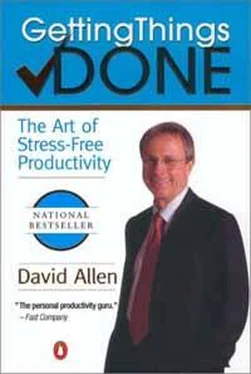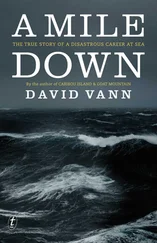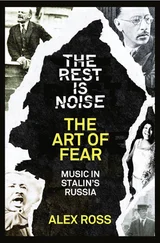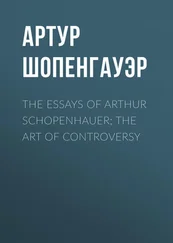What are your key goals and objectives in your work? What should you have in place a year or three years from now? How is your career going? Is this the life-style that is most fulfilling to you? Are you doing what you really want or need to do, from a deeper and longer-term perspective?
The explicit focus of this book is not at those "30,000-" to "50,000+-foot" levels. Urging you to operate from a higher perspective is, however, its implicit purpose—to assist you in making your total life expression more fulfilling and better aligned with the bigger game we're all about. As you increase the speed and agility with which you clear the "runway" and "10,000-foot" levels of your life and work, be sure to revisit the other levels you're engaged in, now and then, to maintain a truly clear head.
How often you ought to challenge yourself with that type of wide-ranging review is something only you can know. The principle I must affirm at this juncture is this:
You need to assess your life and work at the appropriate horizons, making the appropriate decisions, at the appropriate intervals, in order to really come clean.
Which brings us to the ultimate point and challenge of all this personal collecting, processing, organizing, and reviewing methodology: It's 9:22 A.M. Wednesday morning—what do you do?
9. Doing: Making the Best Action Choices
WHEN IT COMES to your real-time, plow-through, get-it-done workday, how do you decide what to do at any given point?
As I've said, my simple answer is, trust your heart. Or your spirit. Or, if you're allergic to those kinds of words, try these: your gut, the seat of your pants, your intuition.
Ultimately and always you must trust your intuition. There are many things you can do, however, that can increase that trust.
That doesn't mean you throw your life to the winds—unless, of course, it does. I actually went down that route myself with some vengeance at one point in my life, and I can attest that the lessons were valuable, if not necessarily necessary. [13] There are various ways to give it all up. You can ignore the physical world and its realities and trust in the universe. I did that, and it was a powerful experience. And one I wouldn't wish on anyone. Surrendering to your inner awareness, however, and its intelligence and practicality in the worlds you live in, is the higher ground. Trusting yourself and the source of your intelligence is a more elegant version of freedom and personal productivity.
As outlined in chapter 2 (pages 48-53), I have found three priority frameworks to be enormously helpful in the context of deciding actions:
• The four-criteria model for choosing actions in the moment
• The threefold model for evaluating daily work
• The six-level model for reviewing your own work
These happen to be shown in reverse hierarchical order— that is, the reverse of the typical strategic top-down perspective. In keeping with the nature of the Getting Things Done methodology, I have found it useful to once again work from the bottom, up, meaning I'll start with the most mundane levels.
The Four-Criteria Model for Choosing Actions in the Moment
Remember that you make your action choices based on the following four criteria, in order:
1 | Context
2 | Time available
3 | Energy available
4 | Priority
Let's examine each of these in the light of how you can best structure your systems and behaviors to take advantage of its dynamics.
Context
At any point in time, the first thing to consider is, what could you possibly do, where you are, with the tools you have? Do you have a phone? Do you have access to the person you need to talk with face-to-face about three agenda items? Are you at the store where you need to buy something? If you can't do the action because you're not in the appropriate location or don't have the appropriate tool, don't worry about it.
As I've said, you should always organize your action reminders by context — "Calls," "At Home," "At Computer," "Errands," "Agenda for Joe," "Agenda for Staff Meeting," and so on. Since context is the first criterion that comes into play in your choice of actions, context-sorted lists prevent unnecessary reassessments about what to do. If you have a bunch of things to do on one to-do list, but you actually can't do many of them in the same context, you force yourself to continually keep reconsidering all of them.
If you're stuck in traffic, and the only actions you can take are calls on your cell phone, you want to be able to pull out just your "Calls" list. Your action lists should fold in or out, based on what you could possibly do at any time.
A second real benefit accrues from organizing all your actions by the physical context needed: that in itself forces you to make the all-important determination about the next physical action on your stuff. All of my action lists are set up this way, so I have to decide on the very next physical action before I can know which list to put an item on (is this something that requires the computer? a phone? being in a store?). People who give them-selves a "Misc." action list (i.e., one not specific to a context) often let themselves slide in the next-action decision, too.
I frequently encourage clients to structure their list categories early on as they're processing their in-baskets, because that automatically grounds their projects in the real things that need to get done to get them moving.
Time Available
The second factor in choosing an action is how much time you have before you have to do something else. If your meeting is starting in ten minutes, you'll most likely select a different action to do right now than you would if the next couple of hours were clear.
Obviously, it's good to know how much time you have at hand (hence the emphasis on calendar and watch). A total-life action-reminder inventory will give you maximum information about what you need to do, and make it much easier to match your actions to the windows you have. In other words, if you have ten minutes before that next meeting, find a ten-minute thing to do. If your lists have only the "big" or "important" things on them, no item listed may be possible to handle in a ten-minute period. If you're going to have to do those shorter action things anyway, the most productive way to get them done is to utilize the little "weird time" windows that occur throughout the day.
Energy Available
Although you can increase your energy level at times by changing your context and redirecting your focus, you can do only so much. The tail end of a day taken up mostly by a marathon budget-planning session is probably not the best time to call a prospective client or start drafting a performance-review policy. It might be better to call the airline to change a reservation, process some expense receipts, or skim a trade journal.
We all have times when we think more effectively, and times when we should not be thinking at all
— Daniel Cohen
Just as having all your next-action options available allows you to take advantage of various time slots, knowing about every-thing you're going to need to process and do at some point will allow you to match productive activity with your vitality level.
I recommend that you always keep an inventory of things that need to be done that require very little mental or creative horsepower. When you're in one of those low-energy states, do them. Casual reading (magazines, articles, and catalogs), telephone/address data that need to be inputted onto your computer, file purging, backing up your laptop, even just watering your plants and filling your stapler—these are some of the myriad things that you've got to deal with sometime anyway.
Читать дальше











